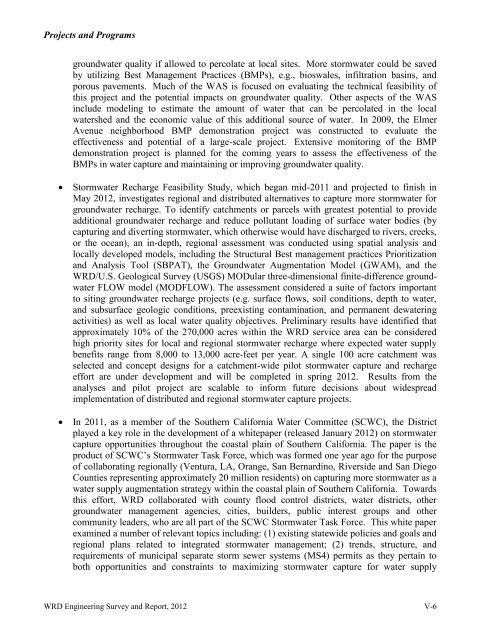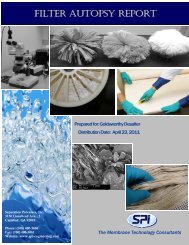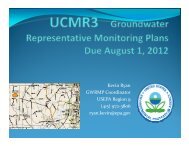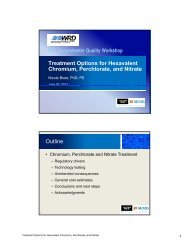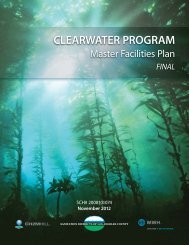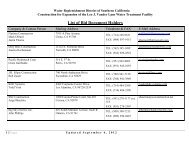Download pdf - Water Replenishment District of Southern California
Download pdf - Water Replenishment District of Southern California
Download pdf - Water Replenishment District of Southern California
You also want an ePaper? Increase the reach of your titles
YUMPU automatically turns print PDFs into web optimized ePapers that Google loves.
Projects and Programs<br />
groundwater quality if allowed to percolate at local sites. More stormwater could be saved<br />
by utilizing Best Management Practices (BMPs), e.g., bioswales, infiltration basins, and<br />
porous pavements. Much <strong>of</strong> the WAS is focused on evaluating the technical feasibility <strong>of</strong><br />
this project and the potential impacts on groundwater quality. Other aspects <strong>of</strong> the WAS<br />
include modeling to estimate the amount <strong>of</strong> water that can be percolated in the local<br />
watershed and the economic value <strong>of</strong> this additional source <strong>of</strong> water. In 2009, the Elmer<br />
Avenue neighborhood BMP demonstration project was constructed to evaluate the<br />
effectiveness and potential <strong>of</strong> a large-scale project. Extensive monitoring <strong>of</strong> the BMP<br />
demonstration project is planned for the coming years to assess the effectiveness <strong>of</strong> the<br />
BMPs in water capture and maintaining or improving groundwater quality.<br />
<br />
<br />
Stormwater Recharge Feasibility Study, which began mid-2011 and projected to finish in<br />
May 2012, investigates regional and distributed alternatives to capture more stormwater for<br />
groundwater recharge. To identify catchments or parcels with greatest potential to provide<br />
additional groundwater recharge and reduce pollutant loading <strong>of</strong> surface water bodies (by<br />
capturing and diverting stormwater, which otherwise would have discharged to rivers, creeks,<br />
or the ocean), an in-depth, regional assessment was conducted using spatial analysis and<br />
locally developed models, including the Structural Best management practices Prioritization<br />
and Analysis Tool (SBPAT), the Groundwater Augmentation Model (GWAM), and the<br />
WRD/U.S. Geological Survey (USGS) MODular three-dimensional finite-difference groundwater<br />
FLOW model (MODFLOW). The assessment considered a suite <strong>of</strong> factors important<br />
to siting groundwater recharge projects (e.g. surface flows, soil conditions, depth to water,<br />
and subsurface geologic conditions, preexisting contamination, and permanent dewatering<br />
activities) as well as local water quality objectives. Preliminary results have identified that<br />
approximately 10% <strong>of</strong> the 270,000 acres within the WRD service area can be considered<br />
high priority sites for local and regional stormwater recharge where expected water supply<br />
benefits range from 8,000 to 13,000 acre-feet per year. A single 100 acre catchment was<br />
selected and concept designs for a catchment-wide pilot stormwater capture and recharge<br />
effort are under development and will be completed in spring 2012. Results from the<br />
analyses and pilot project are scalable to inform future decisions about widespread<br />
implementation <strong>of</strong> distributed and regional stormwater capture projects.<br />
In 2011, as a member <strong>of</strong> the <strong>Southern</strong> <strong>California</strong> <strong>Water</strong> Committee (SCWC), the <strong>District</strong><br />
played a key role in the development <strong>of</strong> a whitepaper (released January 2012) on stormwater<br />
capture opportunities throughout the coastal plain <strong>of</strong> <strong>Southern</strong> <strong>California</strong>. The paper is the<br />
product <strong>of</strong> SCWC’s Stormwater Task Force, which was formed one year ago for the purpose<br />
<strong>of</strong> collaborating regionally (Ventura, LA, Orange, San Bernardino, Riverside and San Diego<br />
Counties representing approximately 20 million residents) on capturing more stormwater as a<br />
water supply augmentation strategy within the coastal plain <strong>of</strong> <strong>Southern</strong> <strong>California</strong>. Towards<br />
this effort, WRD collaborated with county flood control districts, water districts, other<br />
groundwater management agencies, cities, builders, public interest groups and other<br />
community leaders, who are all part <strong>of</strong> the SCWC Stormwater Task Force. This white paper<br />
examined a number <strong>of</strong> relevant topics including: (1) existing statewide policies and goals and<br />
regional plans related to integrated stormwater management; (2) trends, structure, and<br />
requirements <strong>of</strong> municipal separate storm sewer systems (MS4) permits as they pertain to<br />
both opportunities and constraints to maximizing stormwater capture for water supply<br />
WRD Engineering Survey and Report, 2012 V-6


